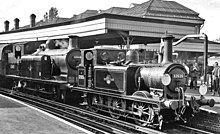
East Sussex is a ceremonial county in South East England. It is bordered by Kent to the northeast, West Sussex to the west, Surrey to the northwest, and the English Channel to the south. The largest settlement is the city of Brighton and Hove, and the county town is Lewes.

The Bluebell Railway is an 11 mi (17.7 km) heritage line in West Sussex in England. It is managed by the Bluebell Railway Preservation Society. It uses steam trains which operate between Sheffield Park and East Grinstead, with intermediate stations at Horsted Keynes and Kingscote.

New Cross Gate is an interchange station between the Windrush line of the London Overground and National Rail services operated by Southern, located in New Cross, London. It is on the Brighton Main Line, 2 miles 70 chains down the line from London Bridge. It is in Travelcard Zone 2.

The London, Brighton and South Coast Railway was a railway company in the United Kingdom from 1846 to 1922. Its territory formed a rough triangle, with London at its apex, practically the whole coastline of Sussex as its base, covering a large part of Surrey. It was bounded on its western side by the London and South Western Railway (L&SWR), which provided an alternative route to Portsmouth. On its eastern side the LB&SCR was bounded by the South Eastern Railway (SER)—later one component of the South Eastern and Chatham Railway (SE&CR)—which provided an alternative route to Bexhill, St Leonards-on-Sea, and Hastings. The LB&SCR had the most direct routes from London to the south coast seaside resorts of Brighton, Eastbourne, Worthing, Littlehampton and Bognor Regis, and to the ports of Newhaven and Shoreham-by-Sea. It served the inland towns and cities of Chichester, Horsham, East Grinstead and Lewes, and jointly served Croydon, Tunbridge Wells, Dorking and Guildford. At the London end was a complicated suburban and outer-suburban network of lines emanating from London Bridge and Victoria, and shared interests in two cross-London lines.

Brighton railway station is the principal station serving the city of Brighton and Hove in England, operated by Govia Thameslink Railway. It is the southern terminus of the Brighton Main Line, the western terminus of the East Coastway Line and the eastern terminus of the West Coastway Line. It is 50 miles 49 chains from London Bridge via Redhill.
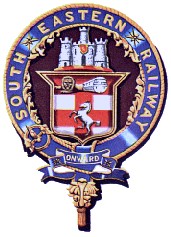
The South Eastern Railway (SER) was a railway company in south-eastern England from 1836 until 1922. The company was formed to construct a route from London to Dover. Branch lines were later opened to Tunbridge Wells, Hastings, Canterbury and other places in Kent. The SER absorbed or leased other railways, some older than itself, including the London and Greenwich Railway and the Canterbury and Whitstable Railway. Most of the company's routes were in Kent, eastern Sussex and the London suburbs, with a long cross-country route from Redhill in Surrey to Reading, Berkshire.
The London and Croydon Railway (L&CR) was an early railway in England. It opened in 1839 and in February 1846 merged with other railways to form the London, Brighton and South Coast Railway (LB&SCR).
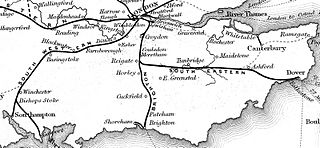
The London and Brighton Railway (L&BR) was a railway company in England which was incorporated in 1837 and survived until 1846. Its railway ran from a junction with the London and Croydon Railway (L&CR) at Norwood – which gives it access from London Bridge, just south of the River Thames in central London. It ran from Norwood to the South Coast at Brighton, together with a branch to Shoreham-by-Sea.
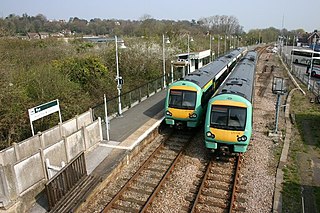
The Marshlink line is a railway line in South East England. It runs from Ashford, Kent via Romney Marsh, Rye and the Ore Tunnel to Hastings where it connects to the East Coastway line towards Eastbourne and Brighton.
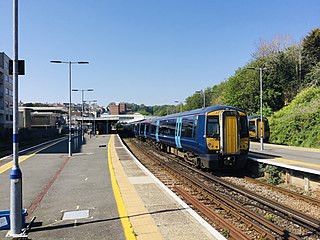
Hastings railway station is the southern terminus of the Hastings line in the south of England and is one of four stations that serve the town of Hastings, East Sussex. It is also on the East Coastway line to Eastbourne and the Marshlink line to Ashford International. It is 62 miles 33 chains (100.4 km) from London Charing Cross measured via Chelsfield and Battle; and 82 miles 33 chains (132.6 km) from Charing Cross via Chelsfield and Ashford.

The East Coastway line is a railway line along the south coast of Sussex to the east of Brighton, England. Trains to the west of Brighton operate on the West Coastway line. Together with the West Coastway and the Marshlink line to the east, the line forms part of a continuous route from Havant to Ashford. The Brighton Main Line route to Eastbourne and Hastings, via Plumpton and Cooksbridge, shares the East Coastway line east of Lewes station.

Eastbourne railway station serves the seaside town of Eastbourne in East Sussex, England. It is on the East Coastway Line. The station is managed by Southern, who operate all trains serving it. It is one of two railway stations in the town, the other being Hampden Park Station. There are also two other stations in the Eastbourne area, one being Pevensey & Westham, in nearby Westham, the other being Polegate.

St Leonards West Marina is a disused railway station in the Bopeep area of the borough of Hastings, East Sussex. Opened by the Brighton, Lewes and Hastings Railway in 1846, it was the first permanent station to serve the area and became part of a feud between two rival railway companies over access to nearby Hastings. Although not very convenient for local services, the station became an important goods rail-head and the location of a Motive Power Depot for steam locomotives working non electrified services, including those to London. The station was closed in 1967 and the buildings subsequently demolished, although in 2023 the down platform could still be seen.
Bulverhythe was a temporary railway station on the Brighton Lewes and Hastings Railway in Bulverhythe, now part of Hastings, East Sussex.
The Brighton and Chichester Railway was an early railway in southern England running between the towns of Shoreham and Chichester in Sussex. It operated between 1845 and 1846.

The London Road Viaduct is a brick railway viaduct in Brighton, part of the city of Brighton and Hove in East Sussex, England. It carries the East Coastway Line between Brighton and London Road railway stations. Built in the 1840s for the Brighton, Lewes and Hastings Railway by the locomotive engineer and railway architect John Urpeth Rastrick, the sharply curving structure has 27 arches and about 10 million bricks. It is still in constant use, and is listed at Grade II* for its historical and architectural significance.
The Croydon and Epsom Railway was an early railway in southern England running between the two Surrey towns mentioned in its name. The company was formed March 1844 to operate a new line using the atmospheric principle. However, before its line was opened it was amalgamated with other companies to form the London, Brighton and South Coast Railway (LB&SCR) on 27 July 1846.

The Surrey and Sussex Junction Railway (SSJR) was an abortive railway scheme to link Croydon to Tunbridge Wells, via Oxted. The company obtained powers to build the line, with the intention that it would be worked by the London Brighton and South Coast Railway (LB&SCR). The project was abandoned, before completion, in 1867. Much of the trackbed was used in the 1880s for the construction of the Oxted line.

The Wimbledon–West Croydon line was a railway line in south London. It was opened in 1855 by the Wimbledon and Croydon Railway (W&CR) over part of the trackbed of the Surrey Iron Railway. It closed in May 1997 and now forms part of the Tramlink network.
Frederick Dale Banister MICE, was an English civil engineer, best known for his 35 years as the Chief Engineer of the London, Brighton and South Coast Railway (LB&SCR).
